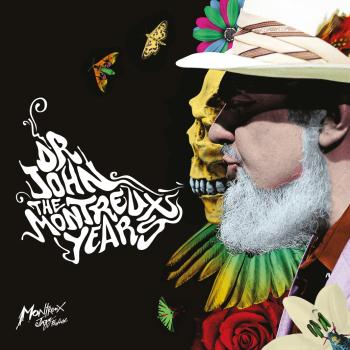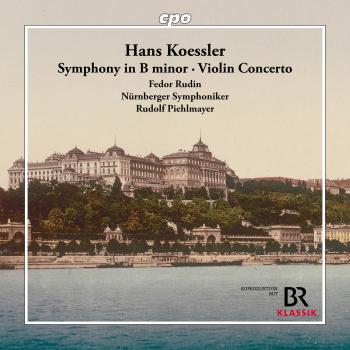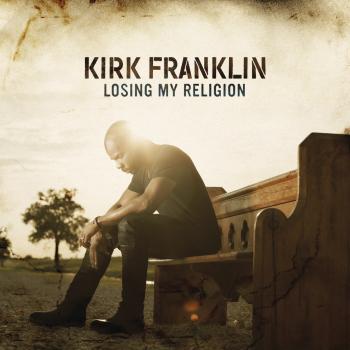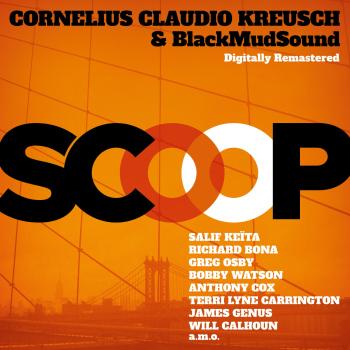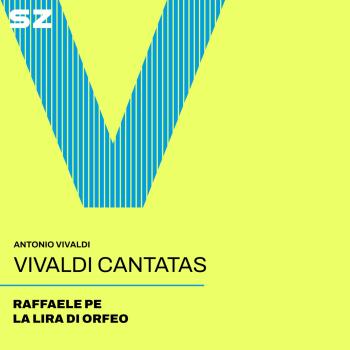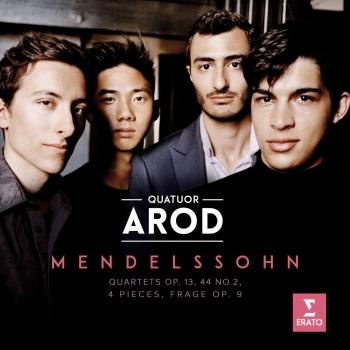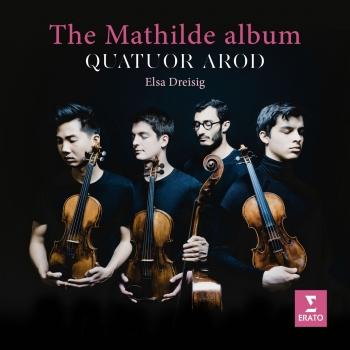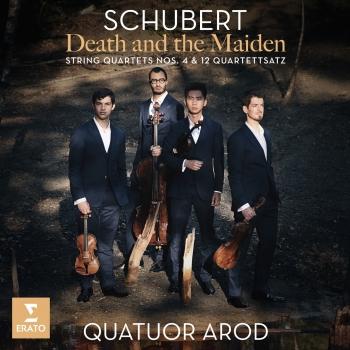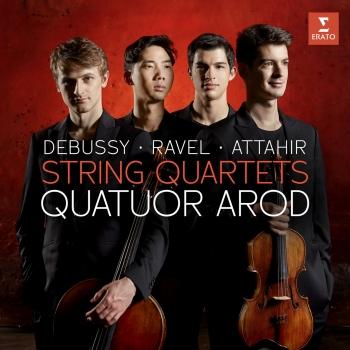
Haydn: String Quartets, Op. 76 Quatuor Arod
Album info
Album-Release:
2025
HRA-Release:
14.11.2025
Label: Warner Classics
Genre: Classical
Subgenre: Chamber Music
Artist: Quatuor Arod
Composer: Franz Joseph Haydn (1732-1809)
Album including Album cover Booklet (PDF)
I`m sorry!
Dear HIGHRESAUDIO Visitor,
due to territorial constraints and also different releases dates in each country you currently can`t purchase this album. We are updating our release dates twice a week. So, please feel free to check from time-to-time, if the album is available for your country.
We suggest, that you bookmark the album and use our Short List function.
Thank you for your understanding and patience.
Yours sincerely, HIGHRESAUDIO
- Joseph Haydn (1732 - 1809): String Quartet in G Major, Op. 76 No. 1, Hob. III:75:
- 1 Haydn: String Quartet in G Major, Op. 76 No. 1, Hob. III:75: I. Allegro con spirito 08:31
- 2 Haydn: String Quartet in G Major, Op. 76 No. 1, Hob. III:75: II. Adagio sostenuto 07:02
- 3 Haydn: String Quartet in G Major, Op. 76 No. 1, Hob. III:75: III. Menuetto. Presto 02:21
- 4 Haydn: String Quartet in G Major, Op. 76 No. 1, Hob. III:75: IV. Finale. Allegro ma non troppo 06:19
- String Quartet in D Minor, Op. 76 No. 2, Hob. III:76 "Fifths":
- 5 Haydn: String Quartet in D Minor, Op. 76 No. 2, Hob. III:76 "Fifths": I. Allegro 09:32
- 6 Haydn: String Quartet in D Minor, Op. 76 No. 2, Hob. III:76 "Fifths": II. Andante o più tosto allegretto 05:35
- 7 Haydn: String Quartet in D Minor, Op. 76 No. 2, Hob. III:76 "Fifths": III. Menuetto 02:55
- 8 Haydn: String Quartet in D Minor, Op. 76 No. 2, Hob. III:76 "Fifths": IV. Finale. Vivace assai 04:17
- 9 Haydn: String Quartet in C Major, Op. 76 No. 3, Hob. III:77 "Emperor": I. Allegro 10:17
- String Quartet in C Major, Op. 76 No. 3, Hob. III:77 "Emperor":
- 10 Haydn: String Quartet in C Major, Op. 76 No. 3, Hob. III:77 "Emperor": II. (a) Poco adagio, cantabile 01:18
- 11 Haydn: String Quartet in C Major, Op. 76 No. 3, Hob. III:77 "Emperor": II. (b) Variation I 01:08
- 12 Haydn: String Quartet in C Major, Op. 76 No. 3, Hob. III:77 "Emperor": II. (c) Variation II 01:18
- 13 Haydn: String Quartet in C Major, Op. 76 No. 3, Hob. III:77 "Emperor": II. (d) Variation III 01:16
- 14 Haydn: String Quartet in C Major, Op. 76 No. 3, Hob. III:77 "Emperor": II. (e) Variation IV 02:00
- 15 Haydn: String Quartet in C Major, Op. 76 No. 3, Hob. III:77 "Emperor": III. Menuetto. Allegro 04:16
- 16 Haydn: String Quartet in C Major, Op. 76 No. 3, Hob. III:77 "Emperor": IV. Finale. Presto 05:54
- String Quartet in B-Flat Major, Op. 76 No. 4, Hob. III:78 "Sunrise":
- 17 Haydn: String Quartet in B-Flat Major, Op. 76 No. 4, Hob. III:78 "Sunrise": I. Allegro con spirito 08:48
- 18 Haydn: String Quartet in B-Flat Major, Op. 76 No. 4, Hob. III:78 "Sunrise": II. Adagio 05:37
- 19 Haydn: String Quartet in B-Flat Major, Op. 76 No. 4, Hob. III:78 "Sunrise": III. Menuetto. Allegro 04:22
- 20 Haydn: String Quartet in B-Flat Major, Op. 76 No. 4, Hob. III:78 "Sunrise": IV. Finale. Allegro ma non troppo 04:25
- String Quartet in D Major, Op. 76 No. 5, Hob. III:79:
- 21 Haydn: String Quartet in D Major, Op. 76 No. 5, Hob. III:79: I. Allegretto 04:45
- 22 Haydn: String Quartet in D Major, Op. 76 No. 5, Hob. III:79: II. Largo cantabile e mesto 06:51
- 23 Haydn: String Quartet in D Major, Op. 76 No. 5, Hob. III:79: III. Menuetto. Allegro 02:45
- 24 Haydn: String Quartet in D Major, Op. 76 No. 5, Hob. III:79: IV. Finale. Presto 03:30
- String Quartet in E-Flat Major, Op. 76 No. 6, Hob. III:80:
- 25 Haydn: String Quartet in E-Flat Major, Op. 76 No. 6, Hob. III:80: I. Allegretto 06:20
- 26 Haydn: String Quartet in E-Flat Major, Op. 76 No. 6, Hob. III:80: II. Fantasia. Adagio 06:41
- 27 Haydn: String Quartet in E-Flat Major, Op. 76 No. 6, Hob. III:80: III. Menuetto - Alternativo 03:56
- 28 Haydn: String Quartet in E-Flat Major, Op. 76 No. 6, Hob. III:80: IV. Finale. Allegro spirituoso 06:30
Info for Haydn: String Quartets, Op. 76
For Quatuor Arod, the six string quartets in Haydn’s opus 76 “represent the apogee of the Classical style, but they are also ageless, presenting almost infinite possibilities”. This is Quatuor Arod’s first Erato recording of music from the late 18th century, though the ensemble’s repertoire for the label extends from Bach chorales through Schubert, Mendelssohn, Zemlinsky, Schoenberg, Webern, Debussy and Ravel to the contemporary French composer Benjamin Attahir.
This Haydn project has been close to Arod's heart for a long time, but the players wanted to give it time to mature. “The op. 76 quartets, which were published in 1799, have long fascinated us. Composed when Haydn, the founding father of the string quartet, was in his mid-sixties, they represent him in all his maturity, achievement and mastery as he exploits a broad expressive palette, tempering depth and grandeur with humour. Haydn, who embodies so many characters, was revolutionary for his time. The works in op. 76, which reached a new level of freedom in their form, tempi and lyricism, constitute a turning point in the history of the quartet as a genre. They undoubtedly influenced Beethoven.”
The six quartets include three that carry a nickname: No. 3 is the ‘Emperor’ (its second movement comprises variations on the famous melody that became the national anthem of Austria-Hungary), No. 4 is the ‘Sunrise’, and No. 2 is the ‘Fifths’. The first of the set, which is in G major, has played a determining role in the history of the Quatuor Arod. “It was one of the first works we played, and it has provided a foundation and inspiration since then. Having fallen in love with the first quartet of op. 76 we naturally went on to explore other Haydn opuses, notably numbers 20, 33 and 74, but before long we set our minds on deepening our relationship with the entirety of op. 76. We were fascinated by its inventiveness and richness, so we played each of the quartets separately, several times over several seasons, before venturing to record them.”
In exploring this Classical repertoire, the Arod’s players sought “to play in a way that was faithful to both the spirit and letter of these works. This led us to reconsider certain fundamental choices, notably our choice of bow. The modern bow, invented after the time of Haydn – who was himself a violinist – did not allow us enough flexibility and lightness, which are defining features of his writing …” This situation led the quartet to commission a new set of bows, based on models produced in the 1770s by the celebrated bow-maker brothers François-Xavier and Léonard Tourte. “The impact of the Classical bows was immediate: the articulation became more natural, the responses more flexible, the sound more transparent. They transformed our way of playing, which became lighter, more open and more free.
“Our instruments date from the 17th and 18th centuries, so they were probably already being played when Haydn’s op. 76 was published. That being said, the Arod’s identity derives from a diversity of repertoire, from Bach to contemporary music, which means that our instruments need to be able to respond as much to the finesse of Haydn as to the power of Bartók. For us the Classical bows represent an ideal compromise, since we have not undertaken any modifications to the modern configuration of our instruments. We use these bows for all the Classical repertoire, notably for Mozart.
“All in all, this recording of Haydn’s op. 76 quartets stands as an important landmark in our career, opening a new chapter in our way of approaching the quartet.”
Quatuor Arod
Quatuor Arod Quartet
The Arod quartet was the grand prize winner of the European FNAPEC Chamber Music Competition held in February 2014. At the same time, it also won the special prize awarded by the Pro-Quartet-CEMC (The European Center of Chamber Music) to promising young quartets.
The Arod Quartet was founded in 2013 by four young musicians eager to share and develop their passion for chamber music. As graduate students at the Paris Conservatory of Music and Dance, they presently receive coaching from Jean Sulem, violist and founding member of the Rosamond Quartet. The quartet also continues to work with well known string ensembles such as the Debussy Quartet, the Ebene Quartet, the Diotima Quartet, and the Tokyo Quartet. The members frequently seek artistic advice from cellists François Salque and Jérôme Pernoo.
The Arod Qartet has also been present on the air waves. France Musique, a highly popular classical music station, recently featured the quartet's first recording of music by Beethoven and Brahms.
This energetic ensemble is regularily invited to participate in festivals such as Les Melusicales, Musique a Versaille, Novembre musical de Bonne, Les Cordes en Ballad, the Pontlovoy International Festival, the Debussy Festival, Festivale de Pentecote en Barry, le IN des Vacances de Monsieur Haydn, just to highlight a few.
The quartet recently shared the stage with artists such as clarinetists Michel Lethiec and Romain Guyot, pianists Claire Desert and François Chaplin, as well as the Debussy Quartet.
Beginning October 2014, the Arod Quartet has accepted an invitation by the Artemis Quartet to be in residence with them at the Queen Elisabeth Music Chapel in Brussels.
Booklet for Haydn: String Quartets, Op. 76

